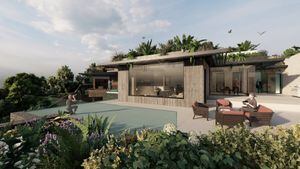‘Invisible’ cliff-top home is a step closer to being built
THE IDLEROCKS could finally be cleared and a new home go up, after planning permission was granted.

The latest application from Ramle Rocks Ltd proposed demolishing the remains of the fire-damaged structure at Jerbourg and building an ‘invisible’ luxury home.
The application was only submitted in early October, with applications often taking eight weeks or longer. But the approval was published this week.
Project architect David Sherwill-Zopf from Lovell Ozanne spent two years preparing the application, and he said the preparation had helped the scheme be approved in just five weeks.
‘We are delighted,’ he said.
The news has been sent to the site owner, and it will be down to them about how to move forward.
‘We are not in a position to comment on our client’s intentions,’ Mr Sherwill-Zopf said.
‘However, this permission is undoubtedly a step in the right direction.’
There was only one objection to the plans, which stated that the site had been used as a hotel for years and should
remain as such, so all islanders could enjoy it.
The cliff-top location has been a hotel since at least the 1940s and had 28 bedrooms in the early 2000s. But in 2003 a kitchen fire caused the business to close. A second fire in 2012 rendered the site unsuitable for habitation.
There has been planning permission granted for a redeveloped hotel in 2014, 2018 and 2020, but work never started.
In 2021 Economic Development, which handles Guernsey’s tourism strategy, said the Idlerocks site was no longer needed as a hotel and they would not object to the site being used for a house instead.
There were a number of considerations for the site, which is adjacent to the cliffs – a site of special significance [SSS].
The planning permission for the site has 19 conditions, with the developer having to take measures to protect the SSS and trees on the site.
The area has a Bronze Age complex, including banks and ditches.
The States archaeology section said it was an area of considerable archaeological importance and this development would see extensive landscaping and excavation. The planners imposed a condition that the developer implement a programme of archaeological work, in a bid to safeguard and record any finds.
Mr Sherwill-Zopf said the conditions had not caused them any concerns.
‘The conditions are mainly pre-commencement conditions that relate to landscape and biodiversity,’ he said.
‘Before the main construction works can begin, we are required to record and safeguard the existing wildlife – as well as protect the trees and neighbouring SSS site. These conditions will need to be discharged before the main build can begin. We will be limited in what we can do in the first part of next year because, for example, the wildlife surveys that need to be undertaken, can only be done between May-September.’





